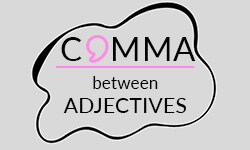
Understanding where to place commas can pose a challenge for numerous students, especially in academic writing. This difficulty often arises due to a lack of complete awareness regarding the rules and exceptions governing comma usage. In this article, our goal is to provide clarity. We furnish examples and elucidate the exceptions related to when commas should be placed between adjectives. Additionally, we present a practice sheet for students to assess their comprehension.
When to place commas between adjectives
Commas are used between adjectives when they are coordinate adjectives, meaning they equally contribute to the same noun, and the order of the adjectives can be rearranged without changing the overall meaning of the sentence. However, commas are not used between cumulative adjectives, meaning they work together to create a single description, and the order of the adjectives is fixed.
To determine whether to use commas, you can try rearranging the order of the adjectives. If the meaning stays the same, use commas; if the meaning changes, no commas are needed.
Comma
Coordinate adjectives
In lists
No comma
Cumulative adjectives
It’s important to point out that the rules for comma usage between adjectives may vary depending on the style guide being followed, such as APA, MLA, or Chicago Style. Additionally, there can be exceptions and variations based on specific contexts or personal preferences. Writers should consult the relevant style guide or consider the specific context to determine the appropriate use of commas between adjectives.
Commas between adjectives
The placement of commas between adjectives is a nuanced aspect of punctuation in English grammar. Knowing when to use or omit commas between adjectives is crucial for effective writing. This section elaborates on the guidelines surrounding instances where commas between adjectives are necessary.
Coordinate adjectives
Coordinate adjectives are adjectives that independently modify a noun, providing distinct and separate pieces of information about it. These adjectives can be rearranged in order without impacting the overall meaning of the sentence. When using coordinate adjectives, it is appropriate to place commas between them. The commas serve to signal that each adjective is contributing individually to the description of the noun. If the same adjective modifies two nouns, you name the adjective twice.
In these sentences, the comma can also be replaced by an “and.”
In lists
Commas are necessary in lists of adjectives to separate two or more coordinate adjectives that equally modify a noun. These adjectives are considered “coordinate” if they can be connected by “and” without influencing the meaning of the sentence, or if their order can be reversed without altering the overall sense.
No commas between adjectives
While there are instances where commas are appropriately used between adjectives, there are also scenarios where no commas are needed. This section explores the concept of cumulative adjectives, where multiple adjectives work together to create a single, unalterable description of a noun. Understanding when to omit commas between adjectives is essential for maintaining clarity and precision in writing.
Cumulative adjectives
Cumulative adjectives are adjectives that work together to form a single, unified description of a noun. Unlike coordinate adjectives, the order of cumulative adjectives is fixed, and they cannot be rearranged without altering the intended meaning of the sentence. In the case of cumulative adjectives, commas are not used between them. The absence of commas signals that these adjectives function cohesively as a unit, each contributing an essential part to the overall description.
Test yourself!
Practice sheet
The sentences below offer an opportunity to practice using commas between adjectives. To check if your answers are correct, refer to the second tab named “answers.”
- She has a beautiful antique vase on the shelf.
- The team celebrated their impressive unexpected victory.
- He wore a fashionable comfortable suit to the event.
- They live in a charming small house in the countryside.
- My sister has an adorable little puppy at home.
- We enjoyed a delicious homemade cake at the party.
- The city has a vibrant lively atmosphere during the festival.
- He owns a rare expensive painting in his collection.
- The children played with colorful wooden toys in the playroom.
- She found an interesting old book at the bookstore.
- She has a beautiful antique vase on the shelf. (No comma)
- The team celebrated their impressive, unexpected victory. (Comma)
- He wore a fashionable, comfortable suit to the event. (Comma)
- They live in a charming small house in the countryside. (No comma)
- My sister has an adorable little puppy at home. (No comma)
- We enjoyed a delicious, homemade cake at the party. (Comma)
- The city has a vibrant, lively atmosphere during the festival. (Comma)
- He owns a rare, expensive painting in his collection. (Comma)
- The children played with colorful, wooden toys in the playroom. (Comma)
- She found an interesting, old book at the bookstore. (Comma)
numerous advantages for Canadian students:
- ✓ 3D live preview of your configuration
- ✓ Free express delivery for every order
- ✓ High-quality bindings with individual embossing

FAQs
It depends on the type of adjectives. Commas are typically used between coordinate adjectives but not between cumulative adjectives.
Yes, in the sentence, “She wore a beautiful, elegant dress,” both “beautiful” and “elegant” are coordinate adjectives separated by a comma.
No, a comma is not typically used before “yet” between adjectives. However, it may be used in certain stylistic or specific contexts.
Commas are used in a list of coordinate adjectives, but not in a list of cumulative adjectives. For example, “He had a large, red, and comfortable chair.” Commas separate the coordinate adjectives “large,” “red,” and “comfortable.”
